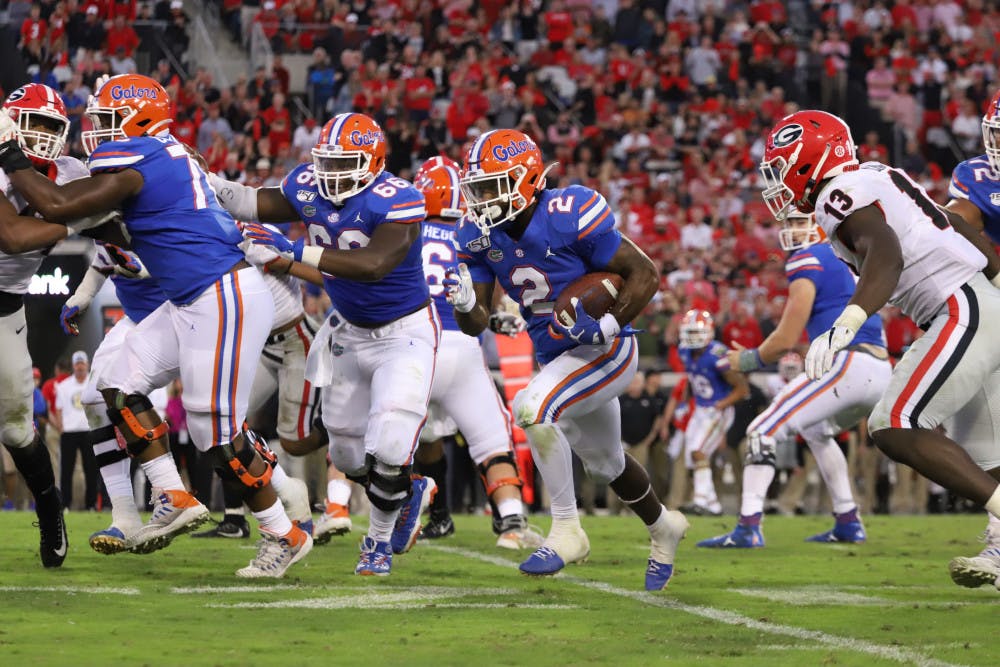The Gators’ offense in 2019 was the polar opposite of 2018’s. Instead of a strong running game and an inconsistent Feleipe Franks behind center, the 2019 Gators had an anemic rushing game and was steady in the air with Kyle Trask. Florida scored more than 30 points in seven games, and everything seemed fine despite a rushing attack stuck in neutral.
But that doesn’t mean there aren’t areas of improvement for Florida with its season opener just three weeks away. Far from it.
Statistically, it is apparent that UF needs to be more explosive on offense while also improving its run blocking.
Explosiveness
For as good as the Gators’ offense was in 2019, it struggled to hit on explosive plays. UF finished the season with 55 plays against FBS competition that gained at least 20 yards—29th among Power 5 competition.
Part of Florida’s problem was that it only had five rushing plays that went more than 20 yards, tied with Stanford for the fewest in the Power 5. In terms of volume, the Gators’ passing attack fared much better in big plays with 50, which was 13th out of the 64 Power 5 teams.
Let’s look at another way to define explosiveness. Collegefootballdata.com’s explosiveness metric measures the average Predicted Points Added (PPA), which is the value of a play, of any “successful” play. Successful plays are any first down where the offense gets at least halfway to the first-down marker, any second down that gains at least 70 percent of the needed yardage to move the chains and any third or fourth down that moves the chains.
Essentially, what we’re looking at here is how big each team’s big plays were: Higher numbers are better. The axes mark the average for explosiveness on passing plays and running plays.
Florida's rare successful running plays were pretty explosive, but its passing attack was below average in terms of explosiveness. One could point to Gators quarterback Kyle Trask’s 14-for-36 performance on passes of at least 20 yards, according to SEC StatCat, as a starting point for improvement.
However, a word of caution on explosiveness: Don’t depend on it. While big plays can heavily swing a game in a team’s favor, it’s likely not repeatable. As Bill Connelly, now at ESPN, wrote for SB Nation in 2017, these plays are pretty random.
While explosiveness is a good thing, it's not necessarily an indicator of good offense. Explosive plays are isolated events among hundreds of plays.
That held true in 2019 as well.
Run blocking
Florida’s offensive line was by far the most-maligned unit on the team last season. Replacing four starters is never easy, but the Gators were still disappointing on that front in 2019.
PFF ranked Florida’s offensive line 92nd in the country last season, and it’s clear that arguably the biggest reason why the Gators couldn’t run the ball was because of that.
Line yards are a way to gauge how good an offensive line is at blocking. Using collegefootballdata.com’s formula, losses are weighted 120 percent, carries of zero to four yards are weighted 100 percent, rushes between five and 10 yards have a weight of 50 percent and nothing for runs longer than 10 yards.
The Gators were an abysmal 111th in the country last season in line yards and the sixth-worst team in the Power 5. Football Outsiders uses a slightly different formula that favors Florida a little more, but they still have UF at 93rd. In an unsurprising turn of events, teams that block better tend to be better at running the ball.
Another way to look at Florida’s ineptitude up front would be looking at a metric called power success: the percentage of runs on third and fourth down within two yards of the sticks that resulted in a first down or touchdown. Power success also factors in successful runs on first and second down within two yards of the end zone.
The Gators were the second-worst Power 5 team in power success (58.2 percent) and 125th in the country, meaning that they struggled to run the ball in short-yardage situations and close to the end zone. The only other SEC team in the triple digits was Vanderbilt at 111th.
Lastly, one could also look at stuff rate to see how much the Gators struggled to block last season. Stuff rate is the percentage of running plays that end behind or at the line of scrimmage, so smaller numbers are better.
The Gators fared a little better in stuff rate, ranking 51st (22.1 percent) in the Power 5. But it’s still clear that Florida lags in the trenches compared to its competition.
Long story short, any improvements in the running game will have to come from the offensive line. It won’t matter how good transfer Lorenzo Lingard or junior Dameon Pierce is if there aren’t any holes to run through. And against SEC defenses loaded with talent in the trenches, Florida will have to be better up front or risk being one-dimensional like last season.
Contact Brendan Farrell at bfarrell@alligator.org and follow him on Twitter @Bfarrell727.
Former Gators running back Lamical Perine at the Florida-Georgia game last year. After having a lackluster run game in 2019, run blocking and explosiveness are too clear areas for Florida to improve on in 2020.






